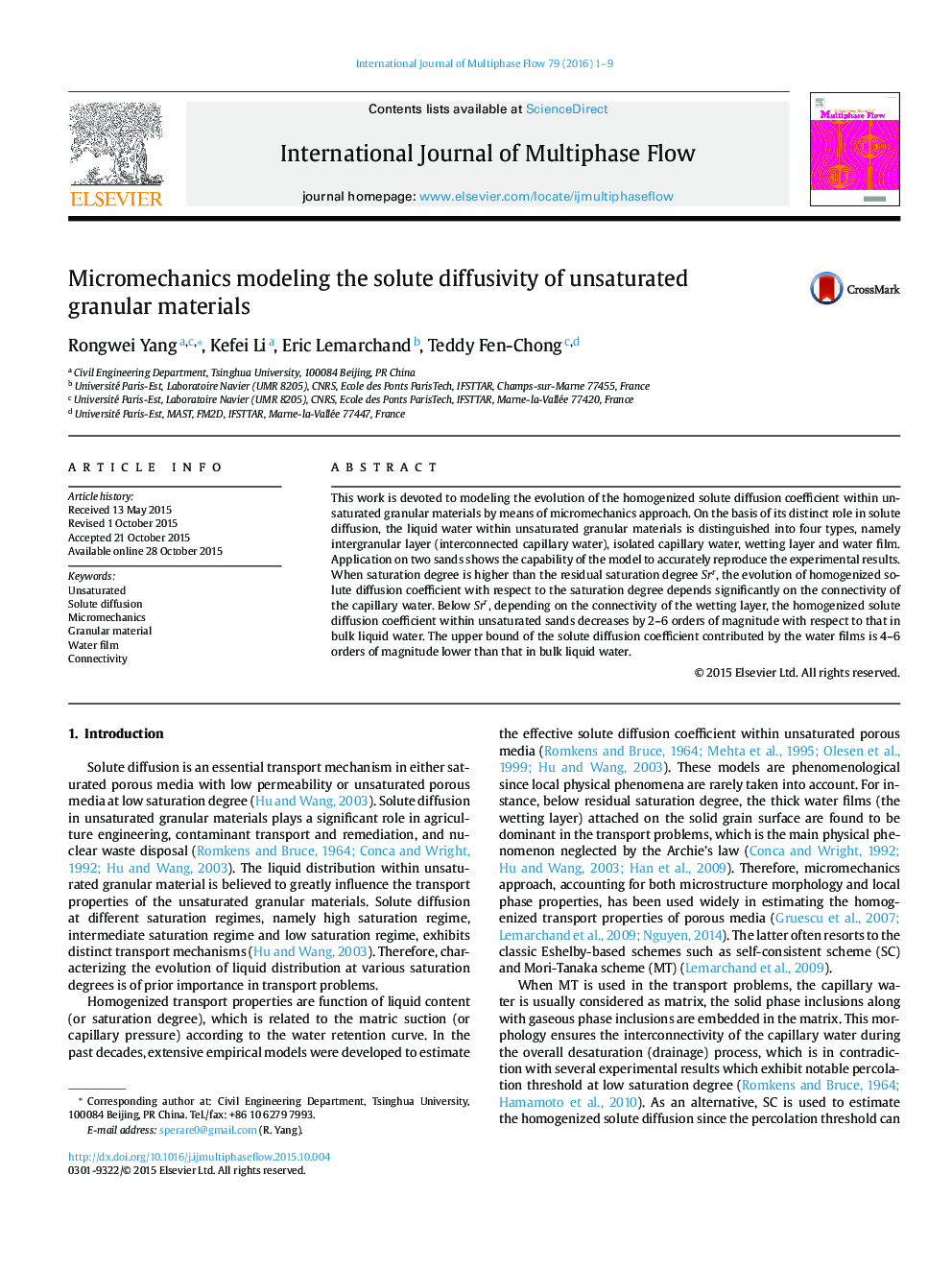| کد مقاله | کد نشریه | سال انتشار | مقاله انگلیسی | نسخه تمام متن |
|---|---|---|---|---|
| 667052 | 1458499 | 2016 | 9 صفحه PDF | دانلود رایگان |
کلمات کلیدی
1.مقدمه
2- مشخصات فیزیکی مواد دانه ای اشباع نشده
1-2- رژیم های اشباع
2-2- ضخامت فیلم آبی
شکل 1: تصویر شماتیک توزیع مایع درون ماده دانه ای اشباع نشده در رژیم های اشباع متمایز
3-2- نفوذ حل شده موضعی داخل فیلم آبی
3- چارچوب نظری
شکل 2: نمایش مورفولوژیکی هر فاز در مواد دانه ای اشباع نشده هنگامی که Sr > Srr (a) یا sr < Srr (b)؛ (b) می تواند رژیم اشباع کم را توسعه دهد (Sr < 1%) هنگامی که لایه خیس کننده متوسط (در کارمین ) ناپدید می شود؛ مسائل می توانند به سه بخش قسمت شوند،
4- کاربرد: نفوذ حل شده نان سوربینگ در ماسه های اشباع نشده
1-4 کسرهای حجمی فاز
جدول 2: پارامترهای تناسب برای دو نوع ماسه
1-1-4 لایه بین دانه ای، آب موئینی جداگانه، و لایه خیس کننده
شکل 3: متحتی های احتباس آب برای ماسه بیور کریک، ماسه رومکنز و ماسه شونای؛ مکش ماتریک با درجه¬های اشباع باقیمانده به ترتیب برای ماسه بیور کریک (%9)، ماسه رومکنز (%7) و ماسه شونای (%13) برابر -20 kPa، -30 kPa و -20 kPa است؛ نتایج تجربی پس از رومکنز و بروس (1964)، لیم و همکاران (1998) و مهتا و همکاران (1995) هستند.
2-1-4 فیلم آب
2-4- نتایج و بحث
1-2-4- ضخامت فیلم آب
جدول 3: پارامترها برای سیستم هوا-فیلم محلول آبی کوارتز-NaCl در T=293 K.
2-2-4- تکامل Dhom/Dτ با Sr (Sr Srr)
شکل 4: رابطه ضخامت فیلم آبی با روطبت نسبی، M = mol.L-1؛ نتایج تجربی برای سیستم فیلم آب ترکیب شده با کوارتز پس از سامنر و همکاران (2004)، ضخامت لایه آب تکی برابر A° 8/2 است (بویرسکی و همکارات، 2002).
شکل 5: تکامل Dhom/Dτ با Sr به هنگام Sr Srr، twl صخامت لایه خیس کننده است، نتایج تجربی پس از رومکنز و بروس (1964) و لیم و همکاران (1998).
3-2-4 تکامل Dhom/Dτ با Sr (Sr < Srr)
شکل 6: تکامل Dhom/Dτ با Sr در ƞ مختلف به هنگام Sr < Srr، منحی سبزآبی خط تیره نقطه نفوذ حل شده توسط فیلم های آبی هستند. (برای بیان ارجاع به رنگ در این شکل، خواننده به نسخه وب این مقاله ارجاع داده می شود).
5- نتایج اظهار شده
ضمیمه A
• Four types of liquid water are distinguished within unsaturated granular materials.
• A micromechanics model is developed to estimate the unsaturated solute diffusion coefficient.
• Below residual saturation degree, the solute diffusion coefficient decreases by 2–6 orders of magnitude of bulk water.
• The maximum solute diffusion contributed by water films will be 4–6 orders lower than that of bulk water.
This work is devoted to modeling the evolution of the homogenized solute diffusion coefficient within unsaturated granular materials by means of micromechanics approach. On the basis of its distinct role in solute diffusion, the liquid water within unsaturated granular materials is distinguished into four types, namely intergranular layer (interconnected capillary water), isolated capillary water, wetting layer and water film. Application on two sands shows the capability of the model to accurately reproduce the experimental results. When saturation degree is higher than the residual saturation degree Srr, the evolution of homogenized solute diffusion coefficient with respect to the saturation degree depends significantly on the connectivity of the capillary water. Below Srr, depending on the connectivity of the wetting layer, the homogenized solute diffusion coefficient within unsaturated sands decreases by 2–6 orders of magnitude with respect to that in bulk liquid water. The upper bound of the solute diffusion coefficient contributed by the water films is 4–6 orders of magnitude lower than that in bulk liquid water.
Journal: International Journal of Multiphase Flow - Volume 79, March 2016, Pages 1–9
